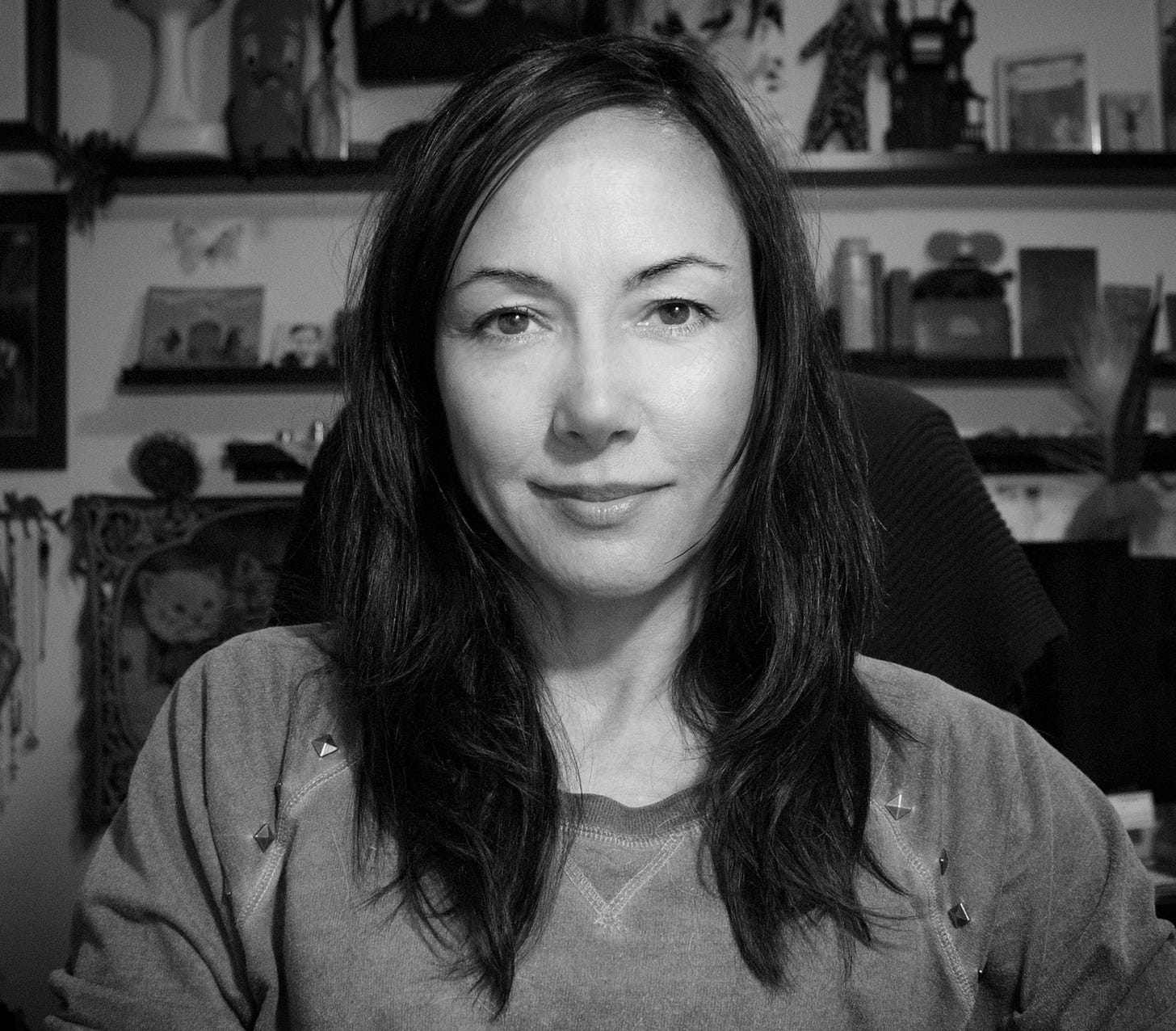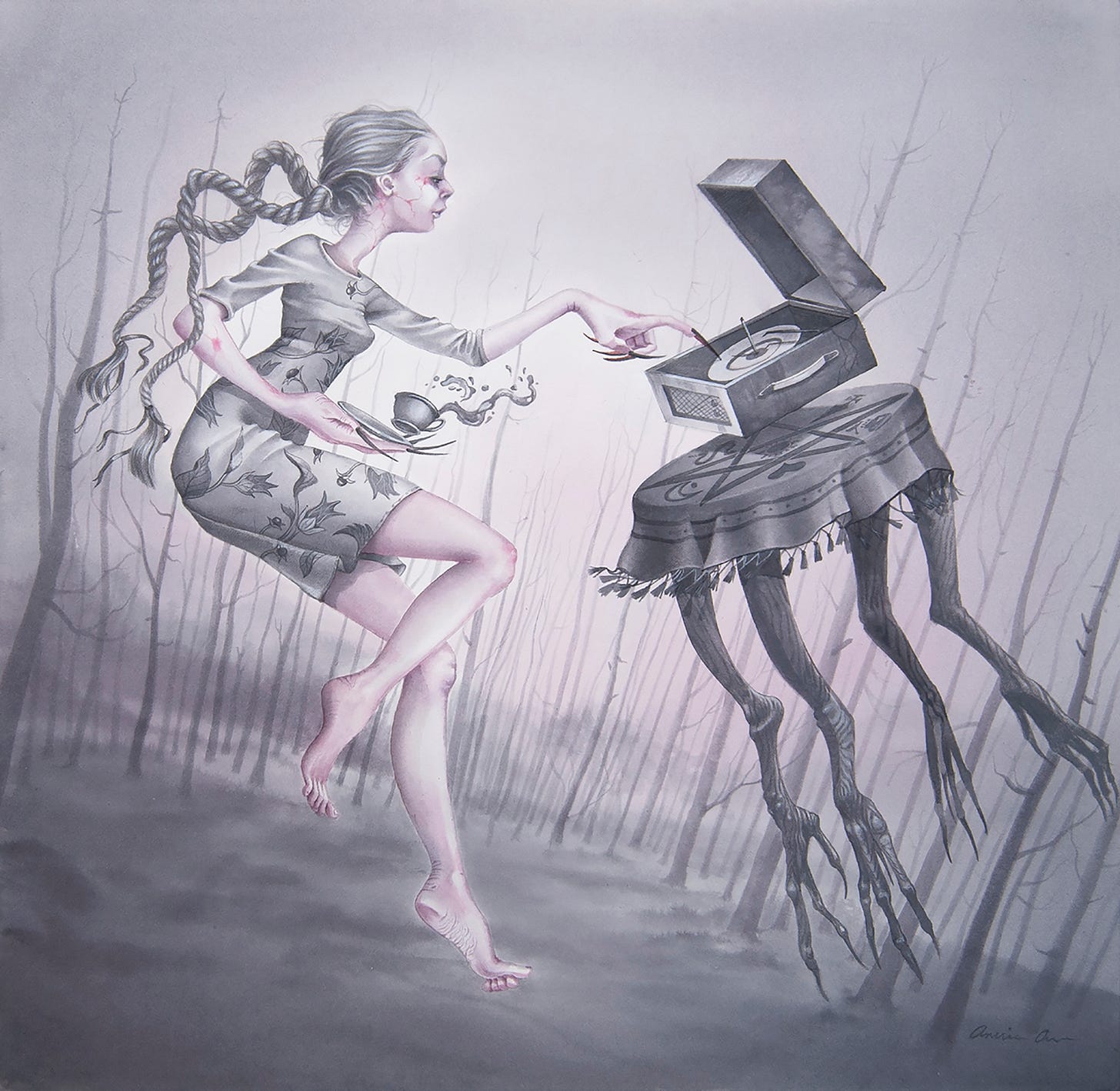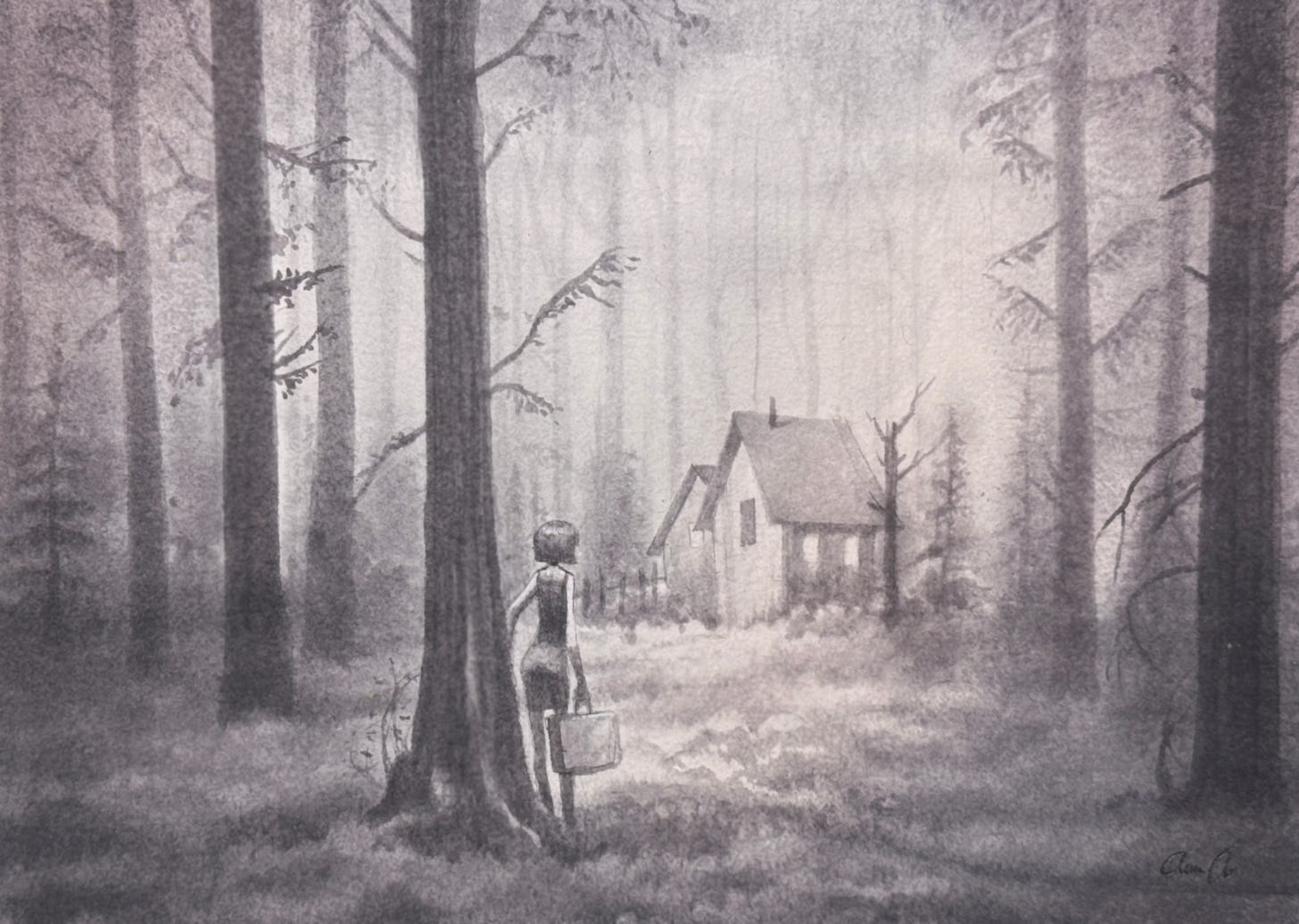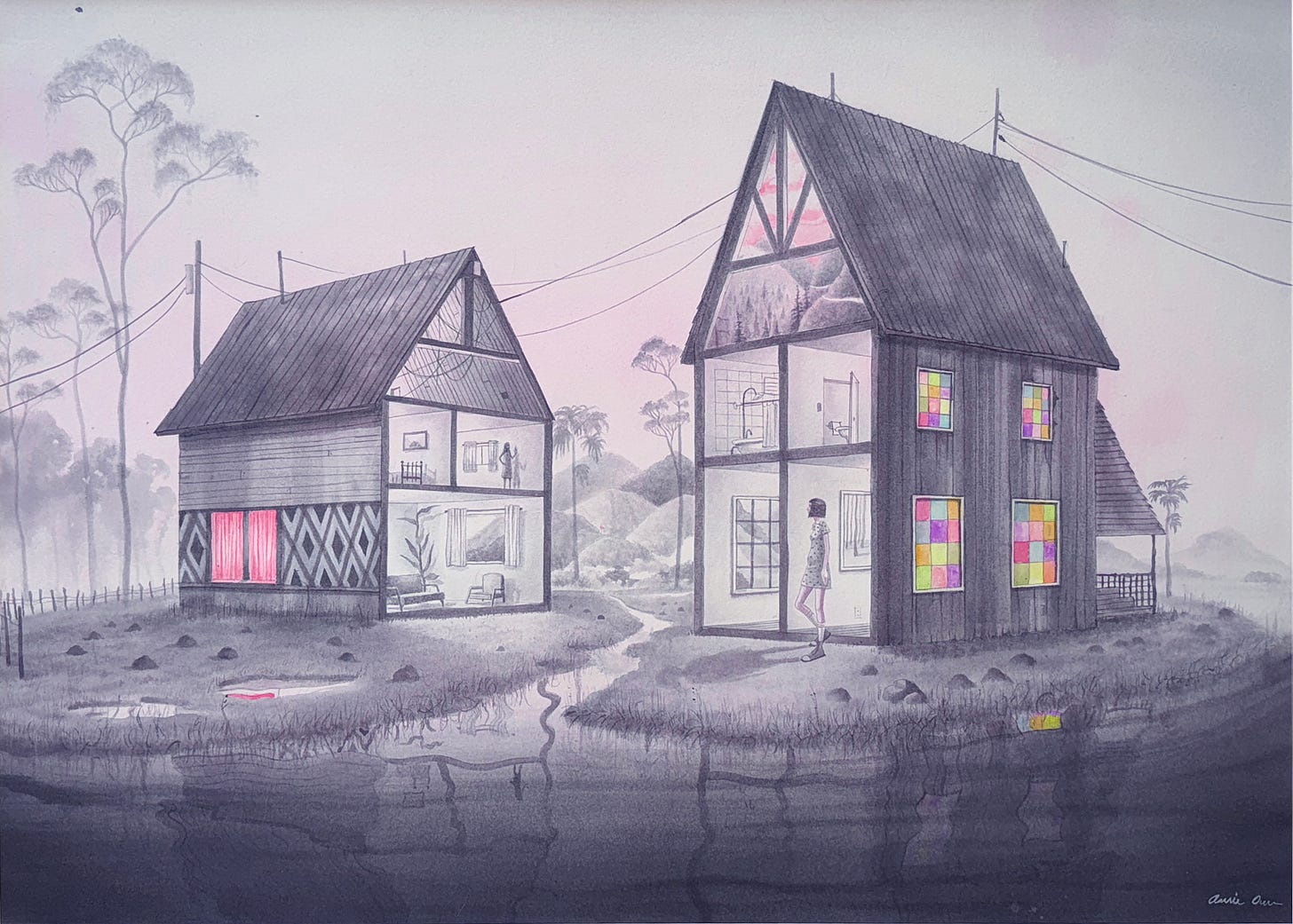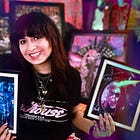CR 069: The Haunting Art of Annie Owens
The painter and co-founder of the iconic Hi-Fructose Magazine discusses her creative process.
In 2005, Annie Owens and Daniel “Attaboy” Seifert had a conversation that would alter the course of their careers. As artists, they had come to recognize that there was a huge gap in the publications covering the visual arts scene. “There was Juxtapoz, who at that time changed their editorial coverage from low brow and pop surrealism to mainly street art and graffiti, and then other magazines that were [covering] what we call ‘living room art,’” Owens says. “But there was so much in between, and we felt like we were part of that missed demographic of artists.” So, on a whim, Seifert proposed that the two start their own publication. “It came about almost by accident. He literally said, ‘We should start a magazine.’ And I was like, ‘Um, okay. Sounds like a great idea.’”
With few resources and no real understanding of the periodical publishing world, the duo launched Hi-Fructose, which over the past 20 years has become a highly respected contemporary art magazine. (Early issues are now collector’s items, with used copies going for over $400 apiece on resale sites.) Owens and Seifert, who are now married, continue to put each quarterly print issue together themselves, with their house serving as the publication’s headquarters.
When she’s not doing the full-time-and-then-some work of running a print magazine, Owens paints. Her moody, atmospheric watercolors have been shown in countless galleries; her sixth solo show was held earlier this year in Berkeley’s Nielsen Arts Gallery.
Over a recent Zoom call, Owens spoke about her background, her creative process, and her advice to aspiring artists.
SANDRA EBEJER: I want to start by asking about your background. I’m curious if you knew from a young age that this is what you wanted to do. Were you raised in a family of artists or art lovers?
ANNIE OWENS: I had artists in my family and musicians in my family, but we were really pragmatic. My parents and my grandparents were immigrants, and they were very much about getting jobs that you could support yourself with and being able to survive and feed yourself. Art wasn’t really something that was encouraged. They gave me crayons and paper, and I always drew and did that little kid thing. I didn’t really consider being an artist until way later in life. I always wanted to be in the arts somewhere, but I didn’t really entertain it in my head as something that I could make a living out of. I didn’t take it seriously until later.
I read that you went to film school. How did that transition to a career in painting?
Gosh, it kind of didn’t. [Laughs] The birth of my daughter played a really big part in changing the trajectory of my life. It was not planned. I was a single mom, and I think my mom felt bad for me. She’s just like, “She likes art. Maybe she’ll go to art school.” I picked film because I really liked movies, so I did a bachelor’s program in that. By then, I really wanted to get out of my mother’s house. It wasn’t the greatest situation. So I went back to my old training, which was in office work. I didn’t do anything in film. I had my bachelor’s degree, and I used that degree to get higher and higher and higher into office work, into being a finance analyst. Totally not natural to what I wanted to do.
The art stuff just happened accidentally. I met my husband, Daniel, and it was the first time I watched someone seriously applying themselves to do things that were creative and art driven. I decided I should start being more serious about art just by watching him, and then also being in a social atmosphere of a lot of artists. I was already steeped in that kind of world. So coming up in the art that way—nothing against formal training, but how I realized art was through graffiti and album cover art and comic books. People’s art would develop organically that way, and I feel like mine developed that way, too.
The first painting of yours that I ever saw was “Samara Rises,” which paid homage to The Ring. And I read in an interview that you love the illustrations from the old Scary Stories to Tell in the Dark books. Are horror movies and books a big source of inspiration on your work?
Early on. Not so much now. I don’t know what inspires me now. There’s inspiration, and then there’s influence. What inspires me is what’s going on internally with me. Things that I think of now that are top of mind, personally—aside from the bigger world, because that’s just too big for me to make art with—is aging and being a woman, especially now. Being half-Filipino and half-white has never really been part of what I depicted in my work, and I feel like that’s sort of creeping in. It’s more on my mind now than ever before. I mean, I guess politically and socially, those things are more top of mind now than they were before. I grew up living a mostly white life. It’s funny, the older I get, the more Asian I look. And so depending on where I go, I’m not always automatically seen as a white lady anymore, which I’m kind of proud of. I always felt not part of either and I’m starting to really identify more with that experience. It’s just funny because sometimes Filipinos won’t really accept me as that, and it feels really weird. It’s sort of like hanging in the balance. So that’s where I’m at right now, as far as inspiration for creating work.
But as far as influence, before it was the look and feel of horror movies and Scary Stories to Tell in the Dark. That series was a big influence. I’ve definitely moved away from that, but I still prefer to work in monochrome. I love really vibrant colors in other people’s work, but I just don’t want to work that way.
Do you start a painting knowing in your head what you want it to be? Or does it happen organically as you’re working?
Oh, I totally have this plan, and then it starts to go in a different way, and I go, “Oh God. It’s not doing the thing I wanted it to do.” So yeah, I have a plan, but it doesn’t always come out that way. I’ve learned to let the organic part happen and leave room for the eventual happenstance of a watercolor painting, where before it was like, “No! I have to control everything!” And it’s water. [Laughs] So, yeah, I’ve learned a little bit more to accept the things that happen. But I still will start a brand-new painting if I have this idea that I want two-thirds of the painting to be really bland and open space and a dot appears. I can’t be like, “I’ll just make that a leaf.” It’s like, no, I’ve gotta start over, because it’s not scrubbing out. [Laughs]
I’d love to ask about a few of your paintings. The first is “Tea and Sympathy.” How did that one come about?
A friend of mine, Long Gone John, is the owner of Sympathy Records and he is a huge art collector. He is deep in the indie music scene. He was one of the first people to sign The White Stripes and Hole and then they moved on. He’s such an eclectic person. He does projects, and one of his projects was to put out a book. He asked several artists, not just me, to [participate]. There are tons of really beautiful artworks done by incredible artists. And so that was the image for that. It’s got a record; it’s kind of satanic. I love the image so much. It’s one of my favorite paintings and it was really fun to do. Usually I don’t like to do themed things, but this was so right up my alley. It was really fun.
Another is “Runaway,” which is so hauntingly beautiful. What can you share about that piece?
I did that as a series. Earlier this year I had a show—it was my first show in my own neighborhood in the East Bay—and a friend of mine who owns a frame store and a gallery was like, “Annie, why don’t you do a show here?” And so I did. I did a bunch of paintings and then a series of smaller ones. That was one of the smaller ones. I thought the image was open to interpretation. She’s either considering going there or looking back and running away from it. I don’t know. I just really liked the image of going somewhere, starting something else. She has a suitcase. I have a thing about suitcases and going places.
You mentioned before that you tend to not use a lot of bright colors, but one of your paintings, “Two Sisters,” has a series of bright colors in the windows. What made you decide to use colors in that one?
I love the painting. There’s some paintings that nobody else responds to, but it’s a personal favorite. That’s one of the ones that never got any kind of response, but I really love it. I love color. I’m a complete sucker for translucent children’s blocks. I have a whole bunch of these things in my room that light shines through. My husband buys me baby blocks, and I’ll line them up so that it lines up with my window. I just love the kaleidoscope of color that comes through.
I was really dazzled by it one day, and I thought, “I want to make a painting that has that kind of bright, translucent luminosity.” I don’t think I achieved it with that painting, so I’m going to keep on trying. But that’s what I was going for. And also, houses to me could be representative of myself or a self, like a stand-in for a human figure. You have this shell on the outside, but what is coming through could be really bright and optimistic. I’ve been swimming a lot in sadness and moroseness and kind of a soupy melancholy, and I’m not ready to leave that because I like that space, but I also want to show that there’s hope and positivity and optimism, because I’m feeling that more now. I think I need that more now. There’s a time and place to be morose, but if you can let some of the positivity come through... That’s what that [painting] is.
Do you find it difficult to know when a piece is finished?
No. I know when it’s done. There are times, actually, when I know it’s not done and desperately want it to be done, so I’ll put it away and be like, “I’m tired of looking at this. I feel like it’s never gonna get done. I’ve trapped myself in painting blades of grass.” So, I’ll put it away, I let it sit, I wake up the next morning, and if it still looks done, it’s done. There was one painting that was just a simple little painting. I did it for fun. I thought it was done, and I woke up the next morning, and I was just like, “It needs a rake.” So I put a rake, and it was done. [Laughs]
In addition to painting, you run Hi-Fructose Magazine with your husband. I’m wondering if you can take me back to 2005, when everyone in the world was noticing that print was floundering and you decided it would be a great time to launch a print-only publication focused on the visual arts.
It was not me that said that. It was my partner, Daniel. He goes, “We should start a magazine.” He had already self-published his own vanity projects, like I Hate Cartoons, so he had an idea of the way traditional print publishing worked. And there’s a lot to it. Nowadays you have print-on-demand, but back then it was a whole thing to learn. And he goes, “We can just contact my contact in Canada. I bet you he would print it. Why don’t we ask him what it would cost to print this many?” And so we did that.
He and I will tell this differently. This is the way I remember it: I remember both of us being like, “Well, let’s just do one and we’ll call it ‘Issue 1,’ as if there’s going to be another one. And then maybe not do another one.” [Laughs] Vinyl toys were a big deal back then, and Daniel had his toy figure, so we were just going to put that on there. And we had a friend, Brian McCarty, who had become known for photographing vinyl toys as if they were very important figures. And so that [cover] was Brian’s photograph.
We self-funded it. We knew Ron Turner of Last Gasp [a distributor]. They were like, “Yeah, we’ll take a few.” We didn’t have any idea of how a periodical schedule works. We didn’t have any idea about advertising. We just knew artists, and we interviewed them with fake names and put our fake names as writers. It was just me and Daniel. We had a couple of friends who were smarter than us who said, “I’ll write an article for you.” They were just these loosey-goosey articles.
I don’t remember how or why the second [issue] came around. I think it was because it looked sort of promising with Last Gasp. As a distributor, they were like, “Are you gonna make another one?” I think that’s the way it went. We also didn’t have any money to make a second one, so Daniel had to borrow money from his brother, Charlie. We were able to pay him back, and miraculously, the magazine was making some money to at least pay for the next issue.
A lot of changes happened. Learning that there is an actual periodical schedule—if you want gallery advertisers, they need to rely on a schedule. We couldn’t just make it whenever we felt like it. We had to have a time [frame]. If you advertise a gallery show, it needs to be in front of people at an optimal time that they can see it. So huge learning gaps between then and now. Of course, we have real writers [now]; we have an actual copy editor. Daniel and I are still the ones that pick all of the content, but artists deserve to have their work written about by people who know how to write, and we don’t know how to do that.
How do you balance running the magazine with creating your own work?
It’s a constant struggle. We revisit it every day. Volume 76 just released. From the printer, a bulk of it goes to distribution warehouses, but we receive all of the stuff that we would sell out of our headquarters, which is our house, so it’s a big operation just to get all of the subscriptions out. It’s huge. It’s an undertaking. We finished that yesterday, and we had a little office powwow, and I’m like, “I’ve got to do some painting. How about you?” He’s like, “Yeah, I’ve got to do some painting.” We’re going to table this other stuff for next week, even though we need to get to certain things. It’s a day-by-day thing. We try to make it 9 to 5. Sometimes it’s a 9 to 6, or sometimes it’s 10 to 7. Before, we didn’t have any boundaries. That was bad. We do now.
Is there anything that, as an artist, you aspire to be better at?
Oh, yes. Rendering. I’m also not the best at figure drawing. Instead of film, perhaps I should have taken more figure drawing classes. I’m open to seeing where I lack in technical abilities, because I think that would help me get my ideas across better.
It’s a really difficult time, as you know, for creatives. Do you have any advice for aspiring artists who might want to follow in your footsteps?
Daniel and I talk about this all the time, and it feels weird to say, but recognize what kind of artist you want to be. And it’s kind of embarrassing to admit—for me, too. Like, if I were to say that to somebody, I would want to be able to say it to myself, recognizing what I want out of this. If you enjoy doing this, if you have something to say, of course you should make art. And if you want to sharpen your technical abilities, you should do that. But what do you want out of it?
I want to be remembered. It sounds stupid to say—it almost sounds like I’m saying I want to be famous—but I want to be remembered. I want to have my ideas remembered. Whether I’m there or even close to there or not remains to be seen, but that’s what I want. And that’s going to help me with my trajectory. I don’t think existing squarely on Instagram is going to help me do that. I don’t think that plus an online shop is going to satisfy my desire in that way. It might help pay the mortgage. Maybe I’ll make prints, maybe I can sell directly to people. But in my view, for me, personally, I need to speak directly to galleries and try to make my way that way. I’m just using myself as an example. If you’re happy with selling direct to people, then you should curate your life and your way of doing things in that way.
I hear a lot of artists talk about, “How do I get myself seen?” I believe the old-fashioned ways are still important. You need to send your stuff to galleries. Send your work, ask for shows, get rejected, and be okay with the rejection. The most important thing is ask to be seen, and if somebody says no, ask what you can do, what they need from you. Do you need improvement somewhere? Are you barking up the wrong tree? A lot of thick skin needs to be had. You’ve got to be willing to be rejected.
To learn more about Annie Owens, find her on Instagram.
To learn more about Hi-Fructose, click here.
This interview has been edited for clarity and length.
You might also enjoy…



